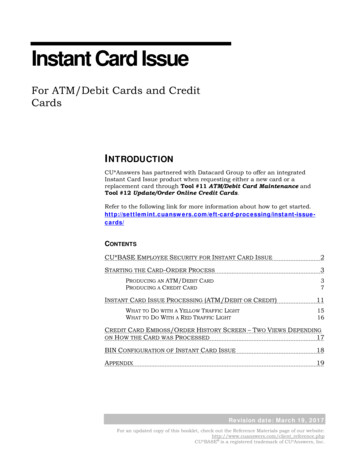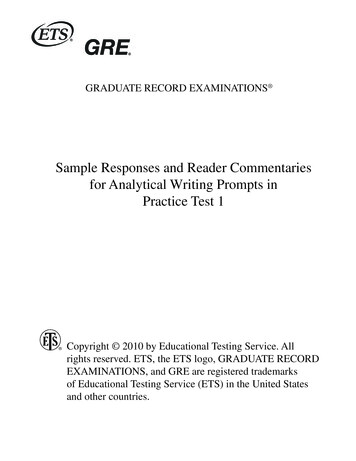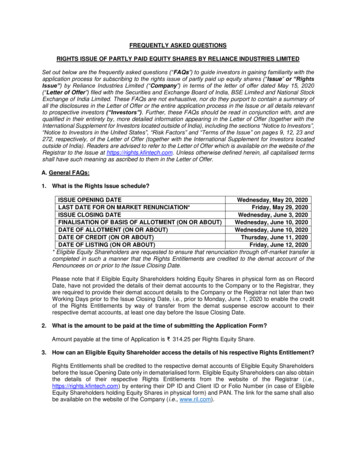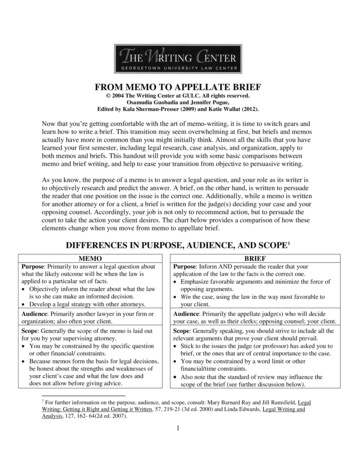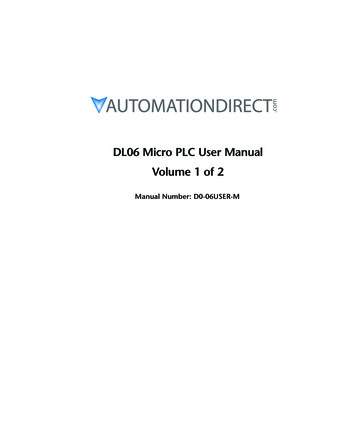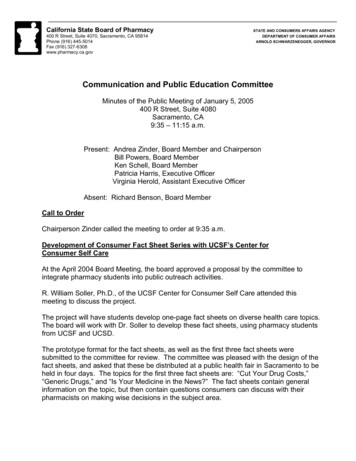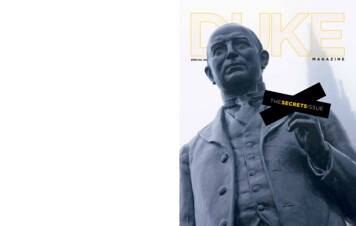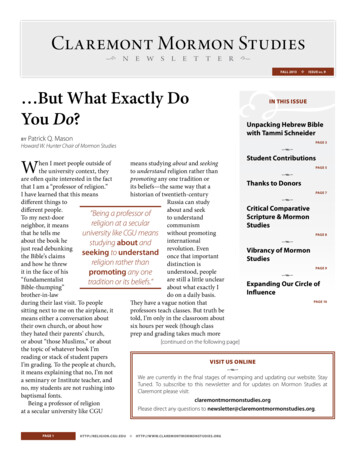
Transcription
Claremont Mormon Studiesj n e w s l e t t e r ifall 2013 But What Exactly DoYou Do?byPatrick Q. MasontIssue no. 9iin this issueUnpacking Hebrew Biblewith Tammi Schneiderpage 3Howard W. Hunter Chair of Mormon StudieskStudent ContributionsWmeans studying about and seekinghen I meet people outside ofpage 5to understand religion rather thanthe university context, theykpromoting any one tradition orare often quite interested in the factThankstoDonorsits beliefs—the same way that athat I am a “professor of religion.”page 7historian of twentieth-centuryI have learned that this meanskRussia can studydifferent things toCritical Comparativeabout and seekdifferent people.“BeingaprofessorofScripture & Mormonto understandTo my next-doorreligion at a secularcommunismneighbor, it meansStudieswithoutpromotingthat he tells meuniversity like CGU meanspage 8internationalabout the book hekstudying about andrevolution. Evenjust read debunkingVibrancy of Mormonseeking to understand once that importantthe Bible’s claimsStudiesreligion rather thandistinction isand how he threwpage 9understood, peopleit in the face of hispromoting any onekare still a little unclear“fundamentalisttradition or its beliefs.“ExpandingOur Circle ofabout what exactly IBible-thumping”Influencedo on a daily basis.brother-in-lawpage 10They have a vague notion thatduring their last visit. To peopleprofessors teach classes. But truth besitting next to me on the airplane, ittold, I’m only in the classroom aboutmeans either a conversation aboutsix hours per week (though classtheir own church, or about howprep and grading takes much morethey hated their parents’ church,or about “those Muslims,” or about[continued on the following page]the topic of whatever book I’mreading or stack of student papersvisit us onlineI’m grading. To the people at church,kit means explaining that no, I’m notWearecurrentlyinthefinalstagesofrevamping and updating our website. Staya seminary or Institute teacher, andTuned. To subscribe to this newsletter and for updates on Mormon Studies atno, my students are not rushing intoClaremont please visit:baptismal fonts.claremontmormonstudies.orgBeing a professor of religionPlease direct any questions to newsletter@claremontmormonstudies.org.at a secular university like CGUPage 1http://religion.cgu.edU tHttp://www.claremontmormonstudies.org
Claremont Mormon Studies Newsletter t fall 2013than that). What do I do with the rest of my time—that is,when I’m not sitting around in my tweed jacket, strokingmy chin, and thinking deep thoughts?The university, and especially the graduate university,is a place where we not only transmit existing knowledge,but also where we create new knowledge. Can you thinkof anything more exciting or fulfilling? This creation ofknowledge is accomplished through conducting originalresearch and then presenting or publishing the findingsof that research. High-quality original research is oftentedious and always time-consuming, especially when onestrives to meet the rigorous standards of academic peerreview. It often takes several years to research and write abook, and at least a few months to write a good article.Much of my time is thus dedicated to research andwriting. In the past year or two I have published a numberof articles (cited below) on topics ranging from violence inearly Mormonism to Mormon blogs to the relationship offaith and history. I was pleased with the publication of thebook War and Peace in Our Time: Mormon Perspectives,which was based on an outstanding conference held atCGU in 2011 and which presents a variety of thoughtfulperspectives on how Latter-day Saints approachperplexing issues of war and peace. I was similarlygratified last year when the Mormon History Associationawarded an article I published in 2011 on the concept of“theodemocracy” in nineteenth-century Mormonism.Books are the gold standard in the fields of historyand religious studies. In addition to my first book, TheMormon Menace, published two years ago, I am currentlyworking on multiple new book projects. My main book,which I am working on slowly but steadily, is a biographyof Ezra Taft Benson, taking into account his entirelife – religion and politics, family and farming. Evenmore slowly, I’m plugging away on a book (co-authoredwith BYU Idaho professor David Pulsipher) that willsystematically explore a Mormon theology of peace. I amalso editing or co-editing two forthcoming collectionsof essays, one stemming from our 2013 Mormon Studiesconference at CGU which honored the vaunted academiccareer of LDS Council member Armand Mauss, andanother that will marshal new research on Mormonism inpost-1945 America.Scholars test out and refine the ideas that eventuallyappear in print by presenting their work at professionalconferences. Since the summer of 2012 I have workedPage 2on accumulating frequent flier miles by participatingin conferences in seemingly every part of the country,and beyond: Mormon History Association conferencesin Calgary, Alberta, and Layton, Utah; the AmericanHistorical Association in New Orleans; the AmericanAcademy of Religion in Chicago; the Western HistoryAssociation in Denver; a symposium of LDS nationalsecurity professionals in Washington, DC; and (byvideoconference) a workshop on collaborative learningtechnologies in Egypt.Of course, I do teach, an activity at the very heart ofthe university. The Hunter Chair is designated to teachone course per semester on Mormonism, and anothercourse on some other aspect of religion, usually Americanreligious history. In the past couple of years I havetaught courses called “Introduction to Mormonism,”“Approaches to Mormonism,” “Gendering Mormonism,”“Mormonism and Politics,” “Religion in America to1865,” “Religion in America, 1865-present,” “Womenin American Religion,” and “Comparative GlobalFundamentalisms.” One of the benefits of teachinggraduate students is that I often leave our classroomdiscussions having learned something new and interestingfrom them. I also spend several hours every week advisingstudents on coursework, research, progress toward theirdegrees, and career goals.Of course, the 2012 presidential election broughtan onslaught of media attention, most of which hassince waned. Nevertheless, the contacts I made duringelection season mean that I have continued to appearepisodically in outlets including National Public Radio,The Daily Beast, the Wall Street Journal, ABC News,the Washington Post, KTTV (Los Angeles), and variouspodcasts. I have recently been interviewed or consultedfor two separate documentaries on women in the LDSChurch. I believe this continued presence in variousmedia outlets is an important element of what the HunterChair can accomplish in terms of public education andoutreach, and hopefully also brings positive attention andrecognition to the Mormon Studies program at CGU.As significant as the Hunter Chair is, it does not standalone in the field of Mormon Studies. One of my favoriteparts of the job is networking with other scholars inMormon Studies and cognate fields. I have the privilegeof serving on the board of directors for both the MormonHistory Association and Dialogue Foundation (whichhttp://religion.cgu.edu t http://www.claremontmormonstudies.org
Claremont Mormon Studies Newsletter t fall 2013publishes Dialogue: A Journal of Mormon Thought), aswell as on the steering committee for the Mormon Studiesconsultation of the American Academy of Religion andthe advisory board for the new Mormon Studies Reviewpublished by BYU’s Maxwell Institute. I was fortunate togather with a “summit” of Mormon Studies scholars inUtah this past summer to discuss the future of the fieldand possible collaborations, and was thrilled to be presentas my good friend and colleague Kathleen Flake wasinaugurated as the first Richard Lyman Bushman Chairof Mormon Studies at the University of Virginia. I canconfidently affirm that Mormon Studies—at CGU andelsewhere—has never been stronger, and is poised to makeeven greater contributions in the years to come.If this little taste of what I do sounds enjoyable andexciting, it’s because it is. Now back to work! tSelected Recent Publications War and Peace in Our Time: Mormon Perspectives, coedited with J. David Pulsipher and Richard L. Bushman(Greg Kofford Books, 2012). “Church of Jesus Christ of Latter-day Saints (Mormonism),”co-authored with Armand L. Mauss, World Religions andSpirituality Project, http://www.has.vcu.edu/wrs/profiles/LDS.htm. “Mormonism and Politics,” Forum on ContemporaryMormonism, Religion and American Culture (Winter 2013):22–29. “Mormon Blogs, Mormon Studies, and the MormonMind,” Dialogue: A Journal of Mormon Thought (Fall 2012):12–25. “’The Wars and the Perplexities of the Nations’:Reflections on Early Mormonism, Violence, and the State,”Journal of Mormon History (Summer 2012): 72–89. “Faith and History, Old Testament-Style,” Forum onUniting Faith and History, Religious Educator (2012):142–144. “Visions of Zion: Changes in Mormon Social Ethics,”Christian Century (Aug. 7, 2012). “God and the People: Theodemocracy in NineteenthCentury Mormonism,” Journal of Church and State(Summer 2011): 349–375.“And What Does That Mean?”Unpacking the Hebrew Bible with Dr. Tammi SchneiderbyChristie FrandsenMormon Studies Council MemberDr. Tammi Schneider sweeps into the classroom,greets her students with a brilliant smile, and beforeshe has even taken her seat, she launches into the day’stopic with irrepressible energy and enthusiasm. It feelsto me as if the light in the room suddenly doubles inwattage; any lingering early morning fatigue instantlyevaporates. I learned early on to have my books openand pen in hand or I would quickly be left far behind inthe rapid-fire conversation that will continue withouta lull for the next three hours. Tammi, as she prefers tobe called, quickly puts all her students at ease with herunassuming and personable style, making me feel as if Iam her new best friend. But behind that gregarious andcharming demeanor is one of the world’s premier scholarson women in the Hebrew Bible. And I am lucky enough tobe sitting in on her class!Her resume is impressive and awe-inspiring for mepersonally. Tammi Schneider is the me I might have beenhad I not chosen the life of a full-time mother instead.Here’s how she is described on the Claremont GraduateUniversity (CGU) website:Tammi J. Schneider teaches ancient Near EasternHistory, literature, archaeology and religion and alsowomen in the Hebrew Bible. Her research draws togetherthe varied fields of archaeology, Assyriology and biblicalstudies in an effort to understand the ancient NearEast, especially the interactions among various peoples.She received her doctorate in Ancient History from thehttp://religion.cgu.edu t Http://www.claremontmormonstudies.orgPage 3
Claremont Mormon Studies Newsletter t fall 2013Studies Council where I met Dr. Tammi Schneider forUniversity of Pennsylvania. Her books include: Judges inthe first time. I shared with her my unfulfilled academicthe Berit Olam series; Sarah: Mother of Nations; Mothersdreams and without a moment’s hesitation she said, “Well,of Promise: Women in the Book of Genesis; and Anit’s never too late! Come to my class!” That was all theIntroduction to Ancient Near Eastern Religion. She wasencouragement I needed.the editor for the ancient Near East section of the journalIt is possible I have never been a part of a more eclecticReligious Studies Review, Vice President of the Americanand diverse group of people than the students who takeSchools of Oriental Research and edits the series People ofTammi Schneider’s Women in the Hebrew Bible class.the Ancient World for the Society of Biblical Literature.Sitting around the table, along with a handful of bright,She has worked on numerous archaeological excavations inarticulate, sleep-deprived female doctoral students hopingIsrael and is presently the head of the educational programto follow in Tammi’s footsteps, is an impassioned Jewishat the Tel Akko Excavations where she excavates everyfeminist, a retired army veteran preparing for her secondyear with students from CGU and the Claremont Colleges.career in religious studies, a former districtAlong with her teaching responsibilitiesattorney making the leap from her lucrativeshe presently serves as Dean of the School“After five minuteslegal career to follow her lifelong teachingof Arts and Humanities.in Tammi’s class thedream. Tammi’s disciples run the gamutOh, yes, and did we forget to mentiondifferencesthatdividein age and ethnicity, political and religiousthat she is a wife and mother of 2 youngus cease to matter.”affiliation, and sexual orientation. We evendaughters?have a few brave men, including a delightfulIt seems that Tammi has accomplisheddivinity student from Haiti and a doctoral candidatethe “impossible dream” for women. She has the best offrom Jerusalem. I am the oldest, undoubtedly the mostboth worlds: an exceptionally successful career and aconservative, and possibly the least qualified academically.richly rewarding home life. It would be easy for me to feelBut after five minutes in Tammi’s class the differencesintimidated by someone like her, but Tammi’s genuinethat divide us cease to matter. Tammi molds us into awarmth and friendliness dispels all intimidation.respectful and caring community of learners where allDr. Schneider defies stereotyping. She is an outfeel free to express opinions, be heard and understood, tospoken feminist who is also a devoted and happy wifelisten and be changed. And together we are transportedand mother. She is a meticulous Hebrew scholar withinto the world of the Bible that Tammi opens up to us.a delightful sense of humor. She is an ambitious andHer teaching style is dynamic and engaging and whataccomplished academic who takes the time to coach herI call “organized spontaneity,” with lots of twists anddaughter’s soccer team. She is a formidable critic of sloppyturns and diversions along the way of textual exploration.scholarship with a heart so tender that I have seen herTammi once said “People who speak slowly bore me” – noweep in class.one is boring in Tammi Schneider’s class! She sprinklesHow did I find myself studying with this world-classher lectures liberally with stories of her family, socialscholar? My passion for all things biblical was kindledcommentary, and tales of her adventures on Israeliby a semester abroad in Israel during my sophomorearchaeology digs or dealing with elitist snobs at academicyear at Brigham Young University. When I returnedconferences. But it is the Hebrew text which draws us allfrom that life-altering experience, I changed my majorback.from chemical engineering to ancient scriptures andThose in the class who can read Hebrew (once uponover-loaded my course schedule every semester to makea time I would have been in that group ) take turnsup for lost time. I married after my junior year at BYUreading a verse of the day’s text, followed by Tammi’sand followed my husband to Duke University where hefavorite question: “And what does that mean?” And thenattended law school and I enrolled in classes at the Dukethe magic begins as Tammi “unpacks” each word of theDivinity School (I believe I was the first LDS studenttext, sharing nuances and possibilities in that Hebrewto attend there). But as soon as our first baby arrived, Iword that none of us had ever known. I have had moreabandoned my academic dreams for motherhood. I have“ah-ha” moments in Tammi’s classes than all of my otherabsolutely no regrets about that choice, but I was left withclasses combined as she reveals the truer meanings ofa lingering hunger for all the things I never got the chancethese age-old words.to learn. Fast forward many years, after the last of my 11Among many other academic “claims to fame,”children left for college, I was invited to join the Mormon[see Schneider, 6]Page 4http://religion.cgu.edu t http://www.claremontmormonstudies.org
Claremont Mormon Studies Newsletter t Fall 2013StudentContributionsWe asked students to provide some details about their recent academicwork. Included here are some of their contributions to the field.Alan Clark “‘Perverted by the Most FranticEnthusiasm’: The Embrace of Spiritual Giftsin Early Mormonism,” Mormon ScholarsFoundation Summer Symposium, BrighamYoung University, 2013. “‘We believe in the gift of tongues’: The1906 Pentecostal Revolution and Its Effectson the LDS Use of the Gift of Tongues inthe Twentieth Century,” Mormon HistoricalStudies 14, no. 1 (2013): 67–80.Jon EnglandScholarship, Brigham Young University.Maclane Heward “‘Our First Mission’: Advancing MissionMethodology during the 1835 Mission ofthe Twelve,” Mormon History AssociationAnnual Conference, June 2013.Taunalyn RutherfordChase Kirkham Religious Education Dissertation Grant,Brigham Young University. “The Pre-Adamites and the Politics ofTime,” Mormon History Association AnnualConference, June 2013. “The Great Debate: America’s PastorJohn Philip Newman Confronts MormonApostle Orson Pratt,” Mormon HistoryAssociation Annual Conference, June 2013.Caroline Kline “Nothing So Pleases God as a Thin Body:Holy Anorexia From Tertullian’s Carthageto Alpine Utah,” Sunstone Symposium, SaltLake City, August 2013.Richard LivingstonAlexandria GriffinConversion, Ingolf U. Dalferth and MichaelCh. Rodgers, eds. (Tübingen, Germany:Mohr Siebeck, 2013), 69–80. Margo L. Goldsmith Memorial Fellowship,Claremont Graduate University. Dissertation Grant, Claremont GraduateUniversity, 2013–2014. Taught at California State University–Fullerton, Comparative ReligionDepartment, “Religion and Science” (CPRL397). Taught World Religions and Book ofMormon at Brigham Young Universityduring the summer of 2013. Traveling to India to conduct oral historyresearch with Mormon and Sikh women inDecember.Rachel Hunt Steenblik “Kierkegaard on the Question ConcerningTechnology,” Kierkegaard and thePresent Age Conference, Brigham YoungUniversity, November 2013. “Heavenly Mother: ‘The Throbbing Hungerof Women’s (and Men’s) Souls,’” SunstoneSymposium, Salt Lake City, August 2013.Lincoln Hale Taught at Chaffey College, PhilosophyDepartment, “Introduction to Religion”(PHIL 80). “Through the Lens of Love: Kierkegaard’sCall to See with the Change of Eternity,”The Seventh International Conference,“Honoring the 200th Anniversary ofthe Birth of Søren Kierkegaard,” St. OlafCollege, June 2013. Hugh W. Nibley Fellowship 2013–2014,Neal A. Maxwell Institute for Religious “In Pursuit of Plurality: A Response toAyse Kadayifci-Orellana” published in Summer Fellow, St. Olaf College, HongKierkegaard Library, June–July 2013. “The Relief Society in Japan, 1949–1970,”Mormon History Association AnnualConference, June 2013.http://religion.cgu.edu t Http://www.claremontmormonstudies.orgPage 5
Claremont Mormon Studies Newsletter t Fallfall 2013New Students Join the ProgramMaclane HewardMaclane has been teaching seminary at Lone Peak High School in Northern Utah County for thelast four years and has been granted a one year leave-without-pay to complete coursework at CGU.He completed a B.A. in Public Relations (2008) and a M.A. in Religious Education (2013) both at BYU.His master’s thesis focused on the first mission of the Twelve Apostles in 1835. Maclane served amission to Jackson, Mississippi from 2003 to 2005. He and his wife Maria have been married for sevenyears and have three children, two boys and a girl.Matthew PittsMatthew is from West Jordan, Utah. He graduated with a BA from Brigham Young Universitywhere he studied Political Science and Middle Eastern Studies. Upon receiving his degree Matthewtraveled with his wife to Jerusalem where they lived for six months as he completed a Hebrew studyprogram at the Hebrew University of Jerusalem. After settling in Pleasant Grove, Utah for threeyears, Matthew decided to continue his education. He earned a law degree from the Benjamin N.Cardozo School of Law, the law school of Yeshiva University, in New York City. Matthew also earneda concurrent MA in Modern Jewish History from Yeshiva. Matthew is currently enrolled as a PhDstudent in the History of Christianity and Religions of North America program. His areas of interestinclude the intersection of law and religion, including the historical effects of changes in the legalsystem on religious doctrine and practice within American Christian and Jewish congregations. Heis also interested in the comparative study of Judaism and Mormonism. He served a LDS mission inVenezuela, Maracaibo. He and his wife Jaime have three young sons: Simon, Eli, and Lot.Jeffrey TurnerJeff grew up in Redwood City, California. He attended Washington State University, where hegraduated with a B.A. in philosophy and a B.A. in religious studies. While at WSU he converted toMormonism. Jeff is a first year Master’s student in the general religion program. His research interestsinclude nineteenth-century European emigration, pamphleteering, and international transfer ofideas. He and his wife Lexie currently live in Upland, California.Schneider, continued from page 4Tammi is perhaps best known forher original approach to textualanalysis which she calls “Verbing theCharacters.” She carefully looks atthe verbs which are attached to eachfemale character – verbs that eachone does and verbs that are doneto her. By this simple yet brilliantand ingenious technique, she hasdiscovered aspects of these womenthat no one has ever seen before.These women spring to life beforeour very eyes as we look carefullyat what they did and what was donePage 6to them and allow those actions tospeak for them, to once again givethem a voice that has been silencedfor far too many centuries. As Ilisten to what these women have tosay to me, a 21st century womanwhose life is both dramaticallydifferent and surprisingly similar totheirs, I am overwhelmed with whatI hear and what I have learned andhow I have been changed. My newestbest friends are these magnificentancient women, some of whosenames were never even recorded, butwhose lives have made an indeliblehttp://religion.cgu.edu t http://www.claremontmormonstudies.orgimprint on my heart: Lot’s wife,Hagar, Tamar, Jael.With the inimitable guidance ofDr. Tammi Schneider, I am learningto unpack these ancient sacredstories where I have discovered aworld populated by very real women– a delightfully diverse array ofwomen with passions and problemsvery much like my own, who metthe challenges of their lives withcourage and grace. These womenhave now become friends and sisterswho inhabit not just the pages of myscriptures but a place in my heart. t
Claremont Mormon Studies Newsletter t fall 2013Thanks to Our 2012–2013 DonorsClaremont Mormon Studies represents aunique opportunity to create wider worldwideunderstanding and appreciation of Mormonism. In his2007 endorsement of the Howard W. Hunter Chair ofClaremont Mormon Studies, Elder Jeffrey R. Hollandremarked that as President Hunter considered ways inwhich the Church could be better understood beyondthe language of faith, he had a vision of secular academiccenters fostering a better understanding of the Churchthrough the language of scholarship. If President Hunter“were alive today,” said Elder Holland, “he would beexpressing his deepest gratitude for the vision that islinking his name, and that of the Church he loved, withsuch a distinguished institution as Claremont.”As we fast-forward six years, we’re pleased to reportthat President Hunter’s prophetic vision is now comingto fruition. Last year, thanks to the support of generousdonors, nine new students were able to enroll in theMormon Studies program at Claremont GraduateUniversity. Together with these students, the currentHoward W. Hunter Chair of Mormon Studies, BYUand Notre Dame-trained Dr. Patrick Mason, who hasbeen called upon to provide his insights in diversesettings from the White House, to the Wall StreetJournal, to National Public Radio, to the academy, isproducing world-recognized, cutting-edge scholarshipand commentary on Mormonism. The first recipientsof Claremont’s Robert L. Millet Fellowship, TaunalynRutherford and Clayton Christensen, are exemplars ofthis flourishing academic environment.We extend our deepest gratitude to the followingindividuals who donated to the Claremont MormonStudies Program and the Howard W. Hunter Foundationduring this past year: 500,000 or above Mary Lythgoe Bradford Bryant and Betty Rossiter Roy and Carol Christensen Charles Schofield Bruce and Helen McGregor Dr. Greggory and Dorothy Winder DeVore Carol Pearson Val and Alice Hemming Craig Nelson Mark McPaullin Gordon and Barbara Mauss 50,000 or above Cynthia Kofford Robert and Diane Wilson John and Rebecca Hawkins Morris and Dawn Thurston Dallas Brent Tolton 10,000 or aboveUp to 1000 Armand and Ruth Mauss James Wilkinson Stephen and Jane Bradford Donna West Russ and Christie Frandsen Robert and Diane Wilson Craig and Theresa Rossell Bill and Marilyn Wright Don and Jette Laws Gerald Bowns Rob Briggs Christopher and Jennifer Halloran Anonymous Guy Murray 100,000 or above Menlo F. Smith Donald C. Houle 5000 or above Randall H. and Carole Johnson Weatherford and Lisa Clayton Milan D. Smith 1000 or above Ed Tolman Joseph and Marilyn Bentley Frank and Anna Rolapp Brian and Lisa Palmer Dr. Tammi Schneider Dr. R. Lanier Britsch Regina Vigneault Brooke Jones Williams John R. Williams John and Shirley Carmack LeGrande and Marguerite Eliason Glen Franks Betsy VanDenBerghe Jacqueline Howard AnonymousWe did our best to include all 2012–2013 donors, but weapologize in advance for any oversights and requestnotification of any donors inadvertently left off or listedincorrectly. For any corrections, please email ChristieFrandsen at christiefrandsen@gmail.com.http://religion.cgu.edu t http://www.claremontmormonstudies.orgPage 7
Claremont Mormon Studies Newsletter t fall 2013The Critical Comparative ScriptureProgram and Mormon StudiesbyAndrew SmithPhD Student, Critical Comparative ScripturesAs I am, at the moment, thesole member of CMSSA whois pursuing a degree in the CriticalComparative Scripture program atCGU, I have been asked to give someinsight into that program and how itrelates to Mormon Studies.The Critical ComparativeScripture (CCS) program can be, inmany ways, exactly what the averageperson probably thinks when theyhear the words put together. Yet, atthe same time, it is also somethingcompletely different, morecomplex and theoretically driven,expanding beyond simply lookingat the Scriptures of one tradition incomparison to those of another.Theoretically, this program isbased on critical self-assessmentwithin discursive formationsaccomplished by analyzing closelythe underlying power structures,hierarchies, and unspoken (perhapsunrecognized) forms of thatdiscourse. This involves asking someof the most basic questions, such as:what are you, as a member of saiddiscourse, doing? Why? What doesit mean that you are doing it thisway and not another? The answersare compared to other formationsto assess descriptive and relativedifferences, helping to furtherdevelop understanding of the whysand hows of both formations. Theterm “scripture” comes to refer,then, to the “texts,” both written andPage 8unwritten, which provide the basisfor the whys within that discourse.In this sense, little-s “scripture” is acategorization of texts, objects, anddiscursive norms that determinethe forms and functions of thatdiscourse. It is a broad categorythat includes big-S “Scripture(s),”commonly understood as the holywritings or canon of a given religioustradition.In a similar way, the CCSprogram is also broader thansimply the discourse of comparativereligion. It is concerned with“scripturalization,” or the wayin which the “script” or “text”(the words, language, politics ofdiscourse, etc.) constructs and istransformed into the formationitself, or the phenomenon thatunderlies and governs how we viewthe world around us, our place within it, and how we function therein.In this sense, CCS fully encompassesthe study of religion as onedetermining factor in this process.However, it also extends beyond thescope of what is normally defined asreligion to include many other fieldsor subfields. For example, the studyof “nationcraft” or how a nationaldiscourse will use symbols, signs,and language (such as flags, mottos,pledges of allegiance, uniforms,education, etc.) to socialize andcondition its citizens by impartingvalues (such as freedom, the rulehttp://religion.cgu.edu t http://www.claremontmormonstudies.orgof law, respect for authority, etc.).In short, CCS examines not onlywhat scripture is but what it does forus and what we make it do for us,whether we are conscious of suchaction or not.This theoretical lens can be of usein Mormon Studies in discoveringand analyzing the norms, attitudes,and texts that govern Mormondiscourse. Perhaps it could be saidthat Mormon Studies is uniquelysituated to be primed for such study.Because Mormonism acknowledgesan open canon and a broaderdefinition of scripture as thatwhich is spoken or expressed bythose with authority “when movedupon by the Holy Ghost” (D&C68:4), Mormons are potentiallymore open to the understandingthat differing “texts” can beauthoritative and functional, todiffering degrees, in their formationand identity, than someone, forinstance, who subscribes to theidea of sola scriptura. Mormonscan take authoritative cues, not justfrom the Standard Works, but alsofrom the Church hymnals, fromthe words of latter-day prophetsand apostles, from articles in theEnsign, from rituals and ceremonies,from patriarchal blessings, andfrom other unspoken or unwrittensources. Thus, Mormon Studiesas a discipline may benefit fromexaminations of these specific “texts”
Claremont Mormon Studies Newsletter t fall 2013and how they have influencedand continue influencing thedevelopment of Mormon discou
with BYU Idaho professor David Pulsipher) that will systematically explore a Mormon theology of peace. I am also editing or co-editing two forthcoming collections of essays, one stemming from our 2013 Mormon Studies conference at CGU which honored the vaunted academic career of LDS Council member Armand Mauss, and


